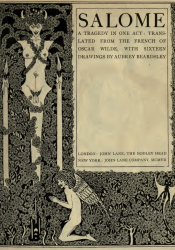First Production of Salome censored
Oscar Wilde’s tragedy Salome was originally intended to debut at the Palace Theatre in London in 1892. The production had a promising start: Wilde had recently found success as a playwright with the production of his society comedy, Lady Windermere’s Fan, in February of that year, and the internationally celebrated actress (and Wilde’s personal friend) Sarah Bernhardt had agreed to fill the leading role. However, the London Examiner of Plays censored the production before it premiered on the basis that it represented biblical figures in perverse and erotic contexts. The play would eventually be published in France in 1893, and translated to English with illustrations by Aubrey Beardsley in 1894.
That Salome’s debut production was shut down due to censorship is hardly surprising. Though by the fin-de-siècle Christianity’s dominance in Victorian England was weakening, the religion remained institutionally powerful. In addition, Wilde was a seminal figure in the late-Victorian Decadent movement that rejected moral evaluations of art, revelled in the taboo, the perverse, and the excess, and railed against the dominant culture through these themes. Salome is no exception: Wilde’s play, as a retelling of the biblical story of the execution of John the Baptist with perverse and erotic twists, was immediately crossing a cultural line. The Examiner of Plays described the production as “half-biblical, half-pornographic” for the lustful actions of several characters. The religiously motivated censoring of Salome demonstrates how Wilde’s play was rejected by the dominant culture and is reflective of its place in the larger Decadent movement of its time.

